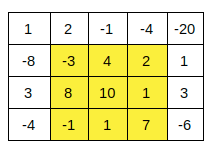Maximum Sum Rectangle in a 2D array
Sample Test case:
Answer
Naive Approach: The naive approach to find the maximum sum rectangle in a 2D array involves generating all possible submatrices and calculating their sum, and then selecting the maximum sum submatrix among them. Each submatrix is generated by selecting its top-left corner and bottom-right corner.
Although this approach is simple to implement, it is not efficient for large inputs since its time complexity is very high. Therefore, more efficient algorithms like Kadane's algorithm for 2D arrays are used to solve this problem.
Code: (C++)
#include <iostream>
#include <bits/stdc++.h>
using namespace std;
int maxSumRectangle(vector<vector<int>>& arr, int n, int m)
{
int nrow = arr.size();
int ncol = arr[0].size();
int maxSum = INT_MIN;
for (int i = 0; i < nrow; i++)
{
for (int j = 0; j < ncol; j++)
{
int topLeft = arr[i][j];
for (int k = i; k < nrow; k++)
{
for (int l = j; l < ncol; l++)
{
int topRight = arr[k][l];
int tempSum = 0;
for (int row = i; row <= k ; row++)
{
for (int col = j; col <= l; col++)
{
tempSum += arr[row][col];
}
}
if (tempSum > maxSum)
{
maxSum = tempSum;
}
}
}
}
}
return maxSum;
}
int main()
{
vector<vector<int>> arr = {{-2, 1, -3, 4},
{5, -6, 7, -8},
{9, -10, 11, -12}};
int n = arr.size();
int m = arr[0].size();
cout << maxSumRectangle(arr, n, m) << endl;
return 0;
}
Optimized Code using Kadane's
Here the left and right pointers define the left and right boundaries of the current sub-rectangle. The running_row_sum array keeps track of the sum of each row in the sub-rectangle, where the sum of each row is calculated incrementally by adding the value of the new column to the previous row sum. Then, Kadane's algorithm is used to find the maximum subarray sum in the running_row_sum array, which corresponds to the maximum sum rectangle for the current sub-rectangle.
Overall, the algorithm works by iteratively creating all possible sub-rectangles by varying the left and right columns, and for each sub-rectangle, it computes the sum of each row by adding values of new columns incrementally. Finally, it finds the maximum sum rectangle in the row sum array using Kadane's algorithm. The algorithm has a time complexity of O(N^3) for an NxN matrix.
Code : (C++)
#include <bits/stdc++.h>
using namespace std;
int kadane(vector<int> arr) {
int max_sum = INT_MIN;
int curr_sum = 0;
for (int num : arr) {
curr_sum = max(num, curr_sum + num);
max_sum = max(max_sum, curr_sum);
}
return max_sum;
}
int maxSumRectangle(vector<vector<int>> matrix, int rows, int cols) {
int max_sum = INT_MIN;
for (int left = 0; left < cols; left++) {
vector<int> running_row_sum(rows, 0);
for (int right = left; right < cols; right++) {
for (int i = 0; i < rows; i++) {
running_row_sum[i] += matrix[i][right];
}
max_sum = max(max_sum, kadane(running_row_sum));
}
}
return max_sum;
}
int main() {
vector<vector<int>> arr = {{1, 2, -1, -4, -20},
{-8, -3, 4, 2, 1},
{3, 8, 10, 1, 3},
{-4, -1, 1, 7, -6}};
int rows = arr.size();
int cols = arr[0].size();
cout << maxSumRectangle(arr, rows, cols) << endl;
return 0;
}


Comments
Post a Comment